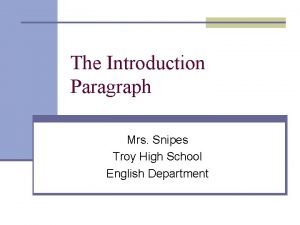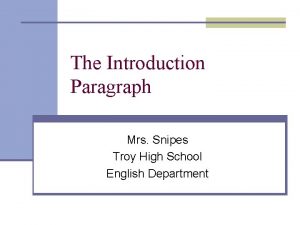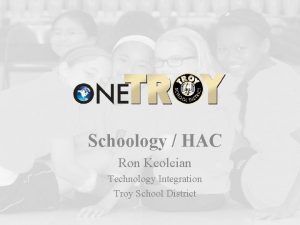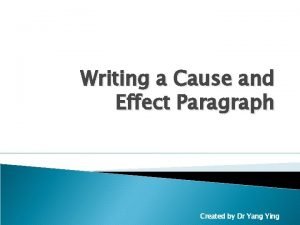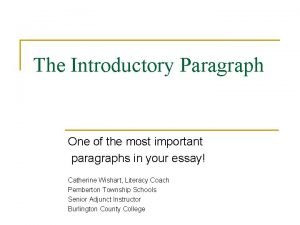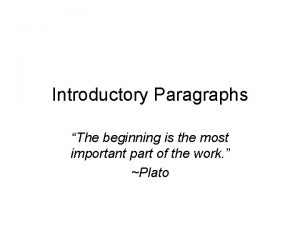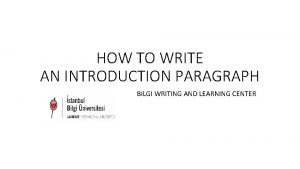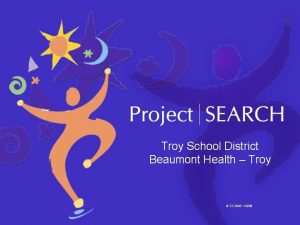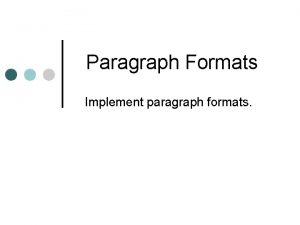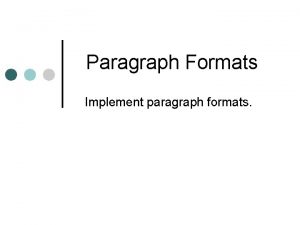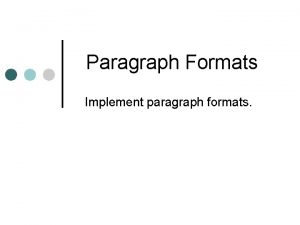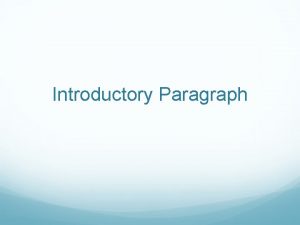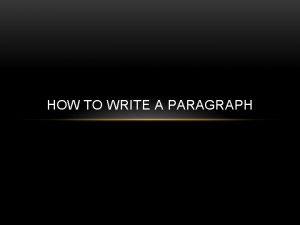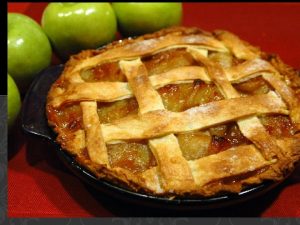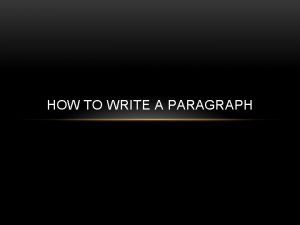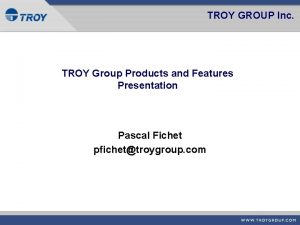The Introduction Paragraph Mrs Snipes Troy High School














- Slides: 14

The Introduction Paragraph Mrs. Snipes Troy High School English Department

The introduction paragraph in an essay of literary analysis functions as follows: n It focuses the reader’s attention on the topic and arouses curiosity for the reader about what you, as the writer, have to say. n It specifies your subject and implies your attitude and tone. n It provides background necessary to understand thesis statement. n It is concise and sincere. n It comes to a point with thesis statement.

Structure of the Introduction Paragraph: n 1 st sentence: hook or opening sentence n 2 nd – 3 rd sentence: transitions from hook while including T. A. G. (complete title, author’s complete name, and genre of the work(s) being analyzed) n 4 th – 5 th sentence: further logical transitions n Thesis Statement: final sentence(s) of the introductions

Strategies for Composing Hooks or Opening Statements: n Use a vivid or powerful quotation that has relevance to your topic. n Create an analogy for your subject. n Offer an interesting fact or statistic. n State an opinion related to your thesis. n Define a concept central to your argument.

What to Avoid When Composing Hooks or Opening Statements: n Cliché statements: “Webster’s dictionary defines n n n friendship as …” First person point of view: “In this essay I will show…” Asking rhetorical questions: “Have you ever wondered what would happen…” (Also avoid addressing the reader) Vague or abstract language Broad generalizations: “Symbolism is a powerful tool used in literature…” Any attempt at humor, cleverness, or sarcasm

Consider the following checklist when composing an introduction paragraph: □ The hook/opening sentence engages the reader’s curiosity while remaining academic and sophisticated. □ The introduction avoids 1 st person point of view, slang, and poor diction. □ Specific terms or language are defined. □ Necessary background information is provided. □ The paragraph transitions clearly and logically from the hook to thesis statement.

□ Avoid vague and abstract language and slang. □ The thesis statement appears at the end of the introduction. □ The introduction should be clear, logical, and reasonable. □ Avoid attempts to be clever, funny, or sarcastic. □ Use present tense verbs consistently.

□ The introduction need not be longer than 4 – 6 sentences. Lengthy introductions tend to ramble and can distract from the topic and lose focus.

Sample Introductions: n As you read the following samples, consider their n n n strengths and weaknesses in light of the previous checklist. Identify the hook or opening statement in each sample. Identify T. A. G. (title, author, genre). Identify transition sentences. Identify thesis statement. Identify awkward, vague, wordy, or abstract diction. Identify analytical and critical approach.

Sample 1: A woman’s role in marriage is a controversial subject that has puzzled and fascinated people as long as the institution of marriage has been in existence. Because women have traditionally held a subservient and passive role in marriage in contrast to their male counterparts, it is of great interest to reflect on world civilizations and cultures of the past in order to observe how contemporary societal expectations of a wife have evolved over time. One powerful way of glimpsing into past societies’ views on wifehood is by carefully examining classical world literature. The Ramayana of Valmiki and The Tale of Genji, examples of classical Indian and Japanese literature and culture, reflect their cultures’ values regarding a woman’s role as a wife.

Sample 2: The persona in Ana Castillo’s short story “Subtitles” narrates, “i have lived my life in a foreign film. ” The idea that she is “typecast” into roles within her life reflects the dominant society’s tendency to categorize her as foreign. This categorization naturally leads to the translation, and therefore transformation, of her character into Anglo-American society. This unique narrative explored theme and character of the contemporary Chicana. Castillo’s “Subtitles” explores the problematic and contradictory nature of the Chicana identity in dominant Anglo. American society through the literary conventions of metaphor, point of view, figurative language, and symbolism.

Sample 3: Human memory is one of the greatest mysteries known to man. Some scientists claim that the human brain’s capacity to store and remember information in infinite. Despite modern technology and advances in brain research, our gift of memory is still one that baffles scientists, physicians, and psychiatrists alike. The mystery of memory intrigues writers, as well. In her award-winning novel Beloved, Toni Morrison explores the intensity of memory in the story of an antebellum family haunted by the past. The controlling theme of memory develops meaning throughout the novel as a narrative technique that weaves insight and emotion into the characters, plot, and symbols.

Sample 4: Among the long list of prerequisites an effective leader must possess, confidence and the ability to speak eloquently and powerfully are necessary to portray a presence of competence. Certainly, any effective leader of historical significance may be shown to have possessed these qualities. In addition to historic figures, characters in the great canon of classical literature also reveal societal expectations of sound leadership. In particular, the playwright’s hand is responsible for depicting, in dramatic form, the role of the heroic leader in all its grandeur. Christopher Marlowe, one of the great playwright’s of the (cont. )

sixteenth century, portrays the character of Tamburlaine as he succeeds to and defends the throne in Tamburlaine the Great, Parts I and II. In Tamburlaine’s character we see a model of leadership in which confidence and eloquence play a pivotal role. Tamburlaine’s pride, confidence, and eloquence qualify him as a competent and effective leader.
 Introductory paragraph examples high school
Introductory paragraph examples high school Troy buchanan high school football
Troy buchanan high school football High school introduction paragraph
High school introduction paragraph They are mrs garcia and mrs castro
They are mrs garcia and mrs castro They are mrs garcia and mrs castro
They are mrs garcia and mrs castro Mrs. darling was ___________ of mrs. s.
Mrs. darling was ___________ of mrs. s. Troy school district enrollment
Troy school district enrollment Grms hac
Grms hac Example of cause and effect paragraph
Example of cause and effect paragraph Introductory hook
Introductory hook Introductory paragraph examples
Introductory paragraph examples How many sentences do you need in a introduction
How many sentences do you need in a introduction Introductory paragraph
Introductory paragraph Crescenta valley high school summer school
Crescenta valley high school summer school Haltom high school summer school
Haltom high school summer school
